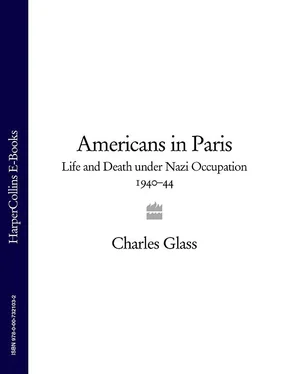Associated Press correspondent Philip W. Whitcomb, a graduate of Washburn University in Kansas and of Oxford, watched the same parade from the pavement and detected a bizarre normality:
On that day the garbage-men cleaned the streets alongside of German troops as they marched up the Friedland and Wagram Avenues or across the Place de la Concorde. The underground railway men ran their trains, though some carried only Germans on their way through Paris. The telephones worked. The police, under instructions to obey German orders, were all on duty, though on June 14th they were little more than members of the silent throng lining the streets through which the Germans moved.
The triumphalism of the military parades offended even a few Germans. A 33-year-old officer, Count Claus Schenk von Stauffenberg, shared his disgust with General Franz Halder and his staff in Paris. Hitler deserved death for this nihilism, von Stauffenberg said. Although Major General Henning von Tresckow was brave enough to second him, General Halder counselled von Stauffenberg that the German public was unlikely to support a coup at a time of military victory.
Martial parades established themselves as facts of daily life that Parisians soon treated with the indifference they accorded to red lights.
TWO
AS THE FIRST GERMAN SOLDIERS took control of Paris that morning, Sylvia Beach was waiting in Adrienne Monnier’s fourth-storey apartment in the rue de l’Odéon. Adrienne’s window commanded a clear view to the north, where the tiny street crossed the tree-shaded boulevard Saint-Germain. A column of German Army trucks and motorcycles appeared, along with troops riding and marching past. Sylvia called it an ‘endless procession of motorized forces: tanks and armored cars and helmeted men seated with arms folded … all a cold grey, and they moved to a steady deafening roar.’ For the first time, Sylvia heard the Germans’ famous leather jackboots. ‘Those boots always made them seem much more enraged than they were,’ she wrote. As she and Adrienne watched, ‘Tears were streaming down our cheeks. It was an awful experience. Horrible.’
‘Miss Beach’, as James Joyce called the American from the time they met in 1920, was 53 years old. Adrienne, her longtime collaborator, friend and former lover, was four years younger. For twenty years, the American and the Frenchwoman had presided over a unique and fertile realm of French and English literature. Adrienne called their little kingdom ‘Odéonia’, for the two bookshops – her French La Maison des Amis des Livres and Sylvia’s English Shakespeare and Company – whose plate-glass windows reflected each other across the rue de l’Odéon. James Joyce, who had made Shakespeare and Company his office, called it ‘Stratford-on-Odéon’.
The modest rue de l’Odéon flowed downhill from the crest of a rise, dominated by the rear of the great Théâtre de l’Odéon, to a roundabout, the Carrefour de l’Odéon, and the boulevard Saint-Germain. A canyon of five-and six-storey apartment buildings rose from ground-floor laundries, antique shops, carpet merchants and printers. Adrienne’s shop was at Number 7, and she lived on the fourth floor of Number 18. Shakespeare and Company was at Number 12, and Sylvia’s flat was in the mezzanine above the shop. The rue de l’Odéon’s twin bookshops, where contemporary writers were supported and published, made it the world capital of Franco-American letters. For a week before the Germans seized Paris, French people, as well as refugees from the Low Countries, had trudged up the rue de l’Odéon on their way out of the city. Sylvia and Adrienne watched them bearing the weight of all the possessions they could carry on their backs. While other booksellers and publishers were fleeing, the two women preferred to remain, if only to guard a small light amid what their friend Arthur Koestler called Europe’s Nazi ‘night’. Sylvia dismissed what many saw as her courage: ‘I never left Paris – hadn’t the energy to flee, luckily, as nothing happened to us or the other monuments.’
Adrienne had come to Odéonia in 1915, opening her bookshop during the war when rents were low and the city’s male booksellers were mostly in the army. From a peasant family in eastern, Alpine France, Adrienne had retained her earthy love of food and all other things sensual. Her father, Clovis, was a postal clerk who sorted mail on trains. An injury he received in a rail accident gave him an insurance settlement that his daughter used to start her business. La Maison des Amis des Livres became more than a bookshop. It was the base for publishing Adrienne’s literary journals and a venue for authors’ readings and discussions. She had befriended and defended some of France’s greatest writers – among them, poets Paul Valéry and Guillaume Apollinaire and novelists André Gide and Jules Romains.
Sylvia Woodbridge Beach arrived a couple of years later. Born in Baltimore in 1887, she had spent two teenage years in Paris from 1902 to 1904, when her father served as Presbyterian clergyman at the American Church on the Quai d’Orsay. From Paris, the family moved to Princeton, New Jersey. The Reverend Sylvester Beach’s most prominent parishioner was Virginia-born Democrat Woodrow Wilson, who was president of Princeton University before being elected governor of New Jersey. The Reverend Sylvester Beach officiated at the weddings of both Wilson daughters and, after Wilson’s election to the White House in 1912, was known as the ‘president’s pastor’. Sylvia, who already spoke French fluently, learned Spanish in Madrid and Italian in Florence before returning to Paris during the Great War in 1917. A course in French literature at the Sorbonne led Sylvia to Adrienne Monnier’s shop in the rue de l’Odéon in search of a French literary journal. In March 1917, the slender, 5-foot-2-inch wisp of an American met the voluptuous French bookseller. Sylvia was thirty and Adrienne almost twenty-six. They discussed American and French books. Adrienne, who spoke little English, said she loved the works of Benjamin Franklin – albeit in French translation. When she told Sylvia, ‘ J’aime beaucoup l’Amérique ,’ Sylvia answered, ‘ J’aime beaucoup la France .’ Soon, they loved each other as well.
Alice B. Toklas called Sylvia ‘flagstaff’ as much for her bony figure as her commitment to flying the banner of American literature on French soil. The American composer Virgil Thompson, who like Aaron Copland and George Antheil came to Paris to study music with Nadia Boulanger, called Sylvia ‘angular … Alice in Wonderland at forty’. Adrienne reminded him of ‘a French milkmaid from the eighteenth century’. William Carlos Williams remembered Adrienne in the kitchen, ‘That woman loved food, the senses were her meat.’ Her dining room was pink, she said, because pink was ‘good for the appetite’. Janet Flanner, who moved to Paris in 1922 with her lover Solita Solano and began her New Yorker column three years later, was a friend of both Sylvia and Adrienne. She compared ‘these two extraordinary women – Mlle. Monnier, buxom as an abbess, placidly picturesque in the costume she had permanently adopted, consisting of a long, full gray skirt, a bright velveteen waistcoat, and a white blouse, and slim, jacketed Sylvia, with her schoolgirl white collar and big colored bowknot, in the style of Colette’s Claudine à l’Ecole’.
Adrienne invited Sylvia to readings in her bookshop, where she heard, among many others, Paul Valéry in French Army uniform read his anti-war poem, ‘Europe’. When the Great War ended in November 1918, Sylvia went to Serbia to help her sister Holly with relief work for the Red Cross. Six months later, she was back in Paris. Adrienne encouraged her to open a French bookshop, like La Maison des Amis des Livres, in New York or London. Both cities proved impractical because of high rents and small readerships for French literature. Sylvia’s fallback was to establish an English language bookshop and lending library in Paris. Adrienne found her space on the ground floor of a building at 8 rue Dupuytren, around the corner from her own shop. With $3,000 sent by her mother, Eleanor Beach, Sylvia opened Shakespeare and Company on 17 November 1919. Above the door hung a pub-like sign of William Shakespeare’s head by the French-Polish painter Charles Winzer. When it was stolen, Winzer painted another. The second too disappeared, and Adrienne made one herself to replace it. Sylvia slept at the back of the tiny shop. Without running water but surrounded by the books she loved, she was content.
Читать дальше












